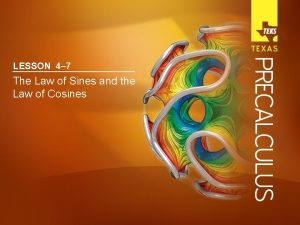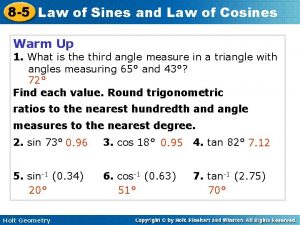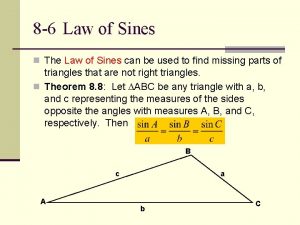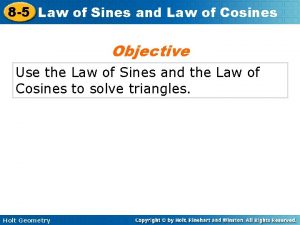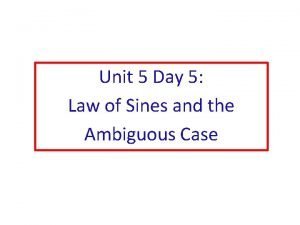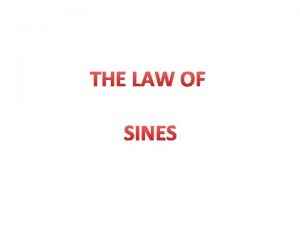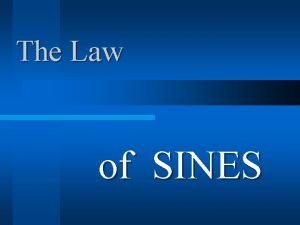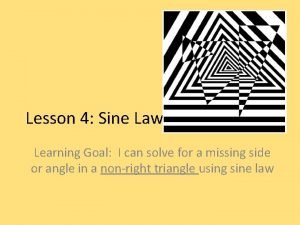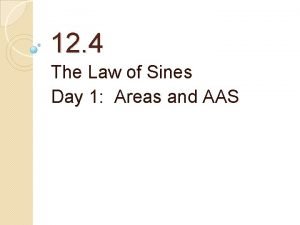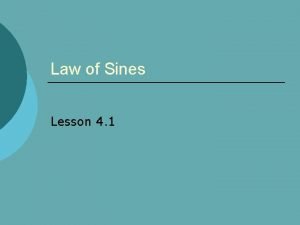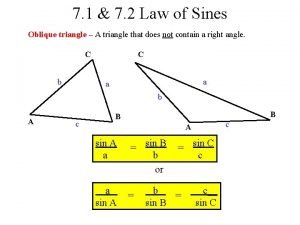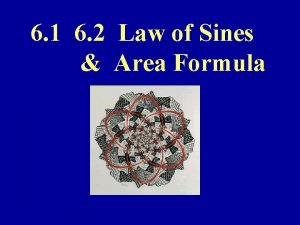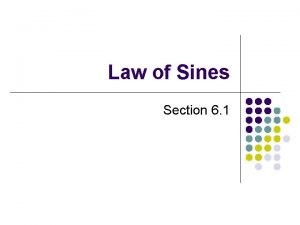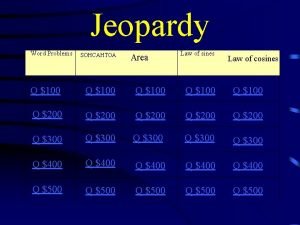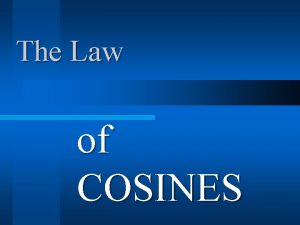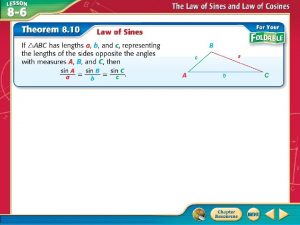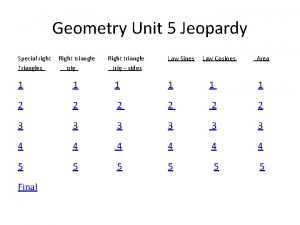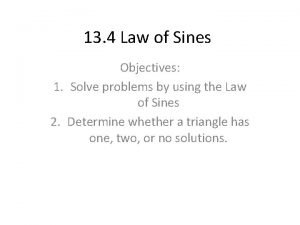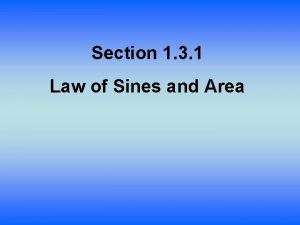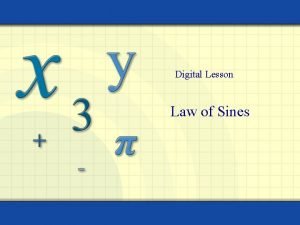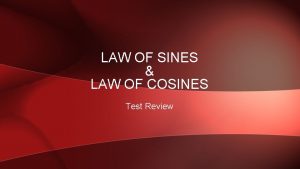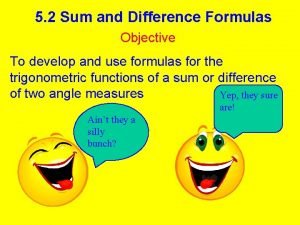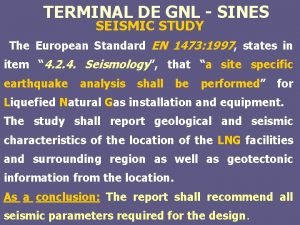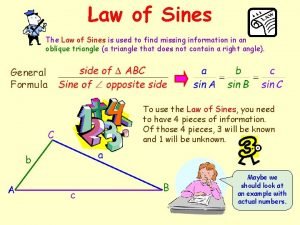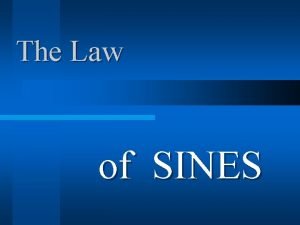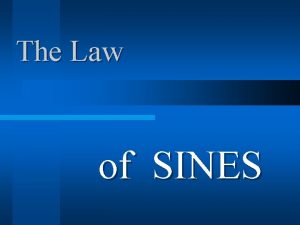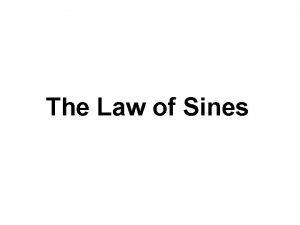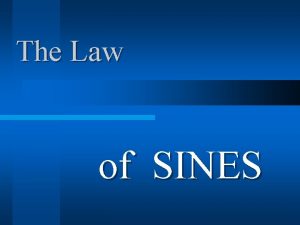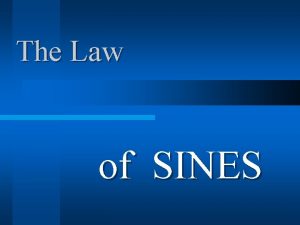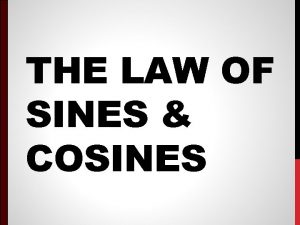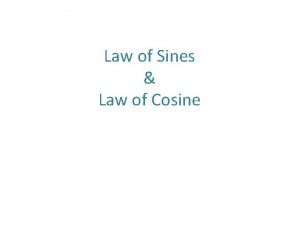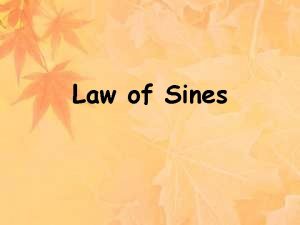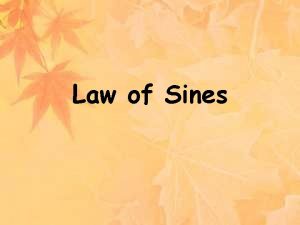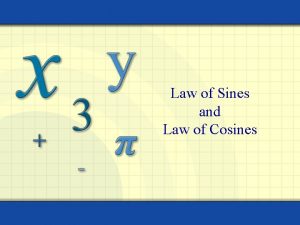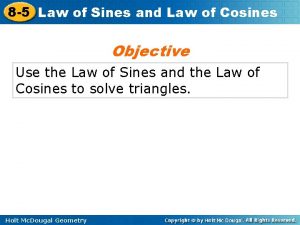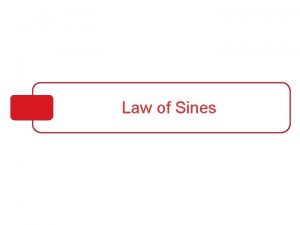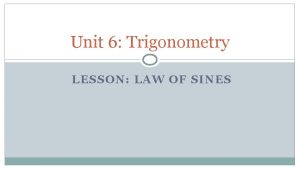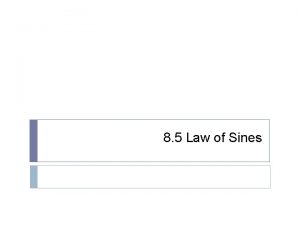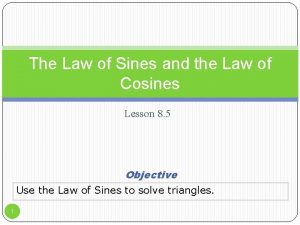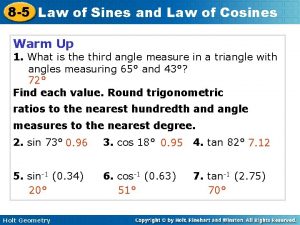6 5 The Law of Sines The Law














































- Slides: 46

6. 5 The Law of Sines

The Law of Sines The trigonometric functions can also be used to solve oblique triangles, that is, triangles with no right angles. For instance, if we are given two angles and the included side, then it’s clear that one and only one triangle can be formed (see Figure 1(a)). ASA or SAA Figure 1(a) 2

The Law of Sines Similarly, if two sides and the included angle are known, then a unique triangle is determined (Figure 1(c)). SAS Figure 1 (c) But if we know all three angles and no sides, we cannot uniquely determine the triangle because many triangles can have the same three angles. 3

The Law of Sines In general, a triangle is determined by three of its six parts (angles and sides) as long as at least one of these three parts is a side. So the possibilities, illustrated in Figure 1, are as follows. (a) ASA or SAA (c) SAS (b) SSA (d) SSS Figure 1 Case 1 One side and two angles (ASA or SAA) Case 2 Two sides and the angle opposite one of those sides (SSA) 4

The Law of Sines Case 3 Two sides and the included angle (SAS) Case 4 Three sides (SSS) Cases 1 and 2 are solved by using the Law of Sines; Cases 3 and 4 require the Law of Cosines. 5

The Law of Sines says that in any triangle the lengths of the sides are proportional to the sines of the corresponding opposite angles. 6

The Law of Sines To state this law (or formula) more easily, we follow the convention of labeling the angles of a triangle as A, B, and C and the lengths of the corresponding opposite sides as a, b, and c, as in Figure 2 7

Example 1 – Tracking a Satellite (ASA) A satellite orbiting the earth passes directly overhead at observation stations in Phoenix and Los Angeles, 340 mi apart. At an instant when the satellite is between these two stations, its angle of elevation is simultaneously observed to be 60 at Phoenix and 75 at Los Angeles. How far is the satellite from Los Angeles? 8

Example 1 – Solution We need to find the distance b in Figure 4 Since the sum of the angles in any triangle is 180 , we see that C = 180 – (75 + 60 ) = 45 (see Figure 4), so we have Law of Sines 9

Example 1 – Solution cont’d Substitute Solve for b The distance of the satellite from Los Angeles is approximately 416 mi. 10

The Ambiguous Case 11

The Ambiguous Case In Example 1 a unique triangle was determined by the information given. This is always true of Case 1 (ASA or SAA). But in Case 2 (SSA) there may be two triangles, one triangle, or no triangle with the given properties. For this reason, Case 2 is sometimes called the ambiguous case. 12

The Ambiguous Case To see why this is so, we show in Figure 6 the possibilities when angle A and sides a and b are given. In part (a) no solution is possible, since side a is too short to complete the triangle. In part (b) the solution is a right triangle. In part (c) two solutions are possible, and in part (d) there is a unique triangle with the given properties. (a) (b) (c) (d) The ambiguous case Figure 6 13

The Ambiguous Case We illustrate the possibilities of Case 2 in the following examples. 14

Example 2 – SSA, the One-Solution Case Solve triangle ABC, where A = 45 , a = 7 , and b = 7. Solution: We first sketch the triangle with the information we have (see Figure 7). Our sketch is necessarily tentative, since we don’t yet know the other angles. Nevertheless, we can now see the possibilities. Figure 7 15

Example 2 – Solution cont’d We first find B. Law of Sines Solve for sin B 16

Example 2 – Solution cont’d Which angles B have sin B = From the preceding section we know that there are two such angles smaller than 180 (they are 30 and 150 ). Which of these angles is compatible with what we know about triangle ABC? Since A = 45 , we cannot have B = 150 , because 45 + 150 > 180. So B = 30 , and the remaining angle is C = 180 – (30 + 45 ) = 105. 17

Example 2 – Solution cont’d Now we can find side c. Law of Sines Solve for c 18

The Ambiguous Case In Example 3 there were two possibilities for angle B, and one of these was not compatible with the rest of the information. In general, if sin A < 1, we must check the angle and its supplement as possibilities, because any angle smaller than 180 can be in the triangle. To decide whether either possibility works, we check to see whether the resulting sum of the angles exceeds 180. 19

The Ambiguous Case It can happen, as in Figure 6(c), that both possibilities are compatible with the given information. In that case, two different triangles are solutions to the problem. The ambiguous case Figure 6(c) 20

Example 3 – SSA, the Two-Solution Case Solve triangle ABC if A = 43. 1 , a = 186. 2, and b = 248. 6. Solution: From the given information we sketch the triangle shown in Figure 8. Note that side a may be drawn in two possible positions to complete the triangle. Figure 8 21

Example 3 – Solution cont’d From the Law of Sines There are two possible angles B between 0 and 180 such that sin B = 0. 91225. Using a calculator, we find that one of the angles is sin– 1(0. 91225) 65. 8. The other angle is approximately 180 – 65. 8 = 114. 2. 22

Example 3 – Solution cont’d We denote these two angles by B 1 and B 2 so that B 1 65. 8 and B 2 114. 2 Thus two triangles satisfy the given conditions: triangle A 1 B 1 C 1 and triangle A 2 B 2 C 2. Solve triangle A 1 B 1 C 1: C 1 180 – (43. 1 + 65. 8 ) = 71. 1 Thus Find C 1 Law of Sines 23

Example 3 – Solution cont’d Solve triangle A 2 B 2 C 2: C 2 180 – (43. 1 + 114. 2 ) = 22. 7 Find C 2 Thus Law of Sines 24

Example 3 – Solution cont’d Triangles A 1 B 1 C 1 and A 2 B 2 C 2 are shown in Figure 9 25

Example 4 – SSA, the No-Solution Case Solve triangle ABC, where A = 42 , a = 70, and b = 122. Solution: To organize the given information, we sketch the diagram in Figure 10. Let’s try to find B. Figure 10 26

Example 4 – Solution cont’d We have Law of Sines Solve for sin B Since the sine of an angle is never greater than 1, we conclude that no triangle satisfies the conditions given in this problem. 27

6. 6 The Law of Cosines 28

The Law of Cosines The Law of Sines cannot be used directly to solve triangles if we know two sides and the angle between them or if we know all three sides. In these two cases the Law of Cosines applies. 29

The Law of Cosines In words, the Law of Cosines says that the square of any side of a triangle is equal to the sum of the squares of the other two sides minus twice the product of those two sides times the cosine of the included angle. If one of the angles of a triangle, say, C, is a right angle, then cos C = 0, and the Law of Cosines reduces to the Pythagorean Theorem, c 2 = a 2 + b 2. Thus the Pythagorean Theorem is a special case of the Law of Cosines. 30

Example 1 – SSS, the Law of Cosines The sides of a triangle are a = 5, b = 8, and c = 12 (see Figure 4). Find the angles of the triangle. Figure 4 31

Example 1 – Solution We first find A. From the Law of Cosines, a 2 = b 2 + c 2 – 2 bc cos A. Solving for cos A, we get 32

Example 1 – Solution cont’d Using a calculator, we find that A = cos– 1(0. 953125) 18. In the same way we get 33

Example 1 – Solution cont’d Using a calculator, we find that B = cos– 1(0. 875) 29 and C = cos– 1(– 0. 6875) 133 Of course, once two angles have been calculated, the third can more easily be found from the fact that the sum of the angles of a triangle is 180. However, it’s a good idea to calculate all three angles using the Law of Cosines and add the three angles as a check on your computations. 34

Navigation: Heading and Bearing 35

Navigation: Heading and Bearing In navigation a direction is often given as a bearing, that is, as an acute angle measured from due north or due south. The bearing N 30 E, for example, indicates a direction that points 30 to the east of due north (see Figure 6). Figure 6 36

Example 2 – Navigation A pilot sets out from an airport and heads in the direction N 20 E, flying at 200 mi/h. After 1 h, he makes a course correction and heads in the direction N 40 E. Half an hour after that, engine trouble forces him to make an emergency landing. (a) Find the distance between the airport and his final landing point. (b) Find the bearing from the airport to his final landing point. 37

Example 2 – Solution (a) In 1 h the plane travels 200 mi, and in half an hour it travels 100 mi, so we can plot the pilot’s course as in Figure 7 38

Example 2 – Solution cont’d When he makes his course correction, he turns 20 to the right, so the angle between the two legs of his trip is 180 – 20 = 160. So by the Law of Cosines we have b 2 = 2002 + 1002 – 2 200 100 cos 160° 87, 587. 70 Thus b 295. 39

Example 2 – Solution cont’d The pilot lands about 296 mi from his starting point. (b) We first use the Law of Sines to find A. 40

Example 2 – Solution cont’d Using the key on a calculator, we find that A 6. 636. From Figure 7 we see that the line from the airport to the final landing site points in the direction 20 + 6. 636 = 26. 636 east of due north. Thus the bearing is about N 26. 6 E. Figure 7 41

The Area of a Triangle 42

The Area of a Triangle An interesting application of the Law of Cosines involves a formula for finding the area of a triangle from the lengths of its three sides (see Figure 8). Figure 8 43

The Area of a Triangle 44

Example 3 – Area of a Lot A businessman wishes to buy a triangular lot in a busy downtown location (see Figure 9). The lot frontages on the three adjacent streets are 125, 280, and 315 ft. Find the area of the lot. Figure 9 45

Example 3 – Solution The semiperimeter of the lot is By Heron’s Formula the area is Thus the area is approximately 17, 452 ft 2. 46
 Law of sines sss
Law of sines sss Lesson 8-5 practice b law of sines and law of cosines
Lesson 8-5 practice b law of sines and law of cosines 8-6 the law of sines
8-6 the law of sines 8-5 law of sines
8-5 law of sines 13-4 law of sines answers
13-4 law of sines answers Classifying triangles maze worksheet answer key
Classifying triangles maze worksheet answer key What is ambiguous case for law of sines
What is ambiguous case for law of sines 12-4 law of sines
12-4 law of sines Ambiguous case in trigonometry
Ambiguous case in trigonometry Law of sines lesson plan
Law of sines lesson plan 12-4 law of sines
12-4 law of sines Law of sines lesson
Law of sines lesson Law of sines and cosines word problems worksheet doc
Law of sines and cosines word problems worksheet doc Law of sines area formula
Law of sines area formula Deriving law of sines
Deriving law of sines Sohcahtoa word problems
Sohcahtoa word problems Law of cosines sas
Law of cosines sas Asa law of sines
Asa law of sines Law of sines
Law of sines Law of sines area
Law of sines area Sss formula
Sss formula What is an ambiguous case in trigonometry
What is an ambiguous case in trigonometry Example of an oblique triangle
Example of an oblique triangle Law of sines and cosines test
Law of sines and cosines test 135628
135628 Sinbad and cosette
Sinbad and cosette Terminal gnl sines
Terminal gnl sines Newton's first law and second law and third law
Newton's first law and second law and third law Si unit of newton's first law
Si unit of newton's first law V=k/p
V=k/p Avogadro's law constant
Avogadro's law constant Hát kết hợp bộ gõ cơ thể
Hát kết hợp bộ gõ cơ thể Frameset trong html5
Frameset trong html5 Bổ thể
Bổ thể Tỉ lệ cơ thể trẻ em
Tỉ lệ cơ thể trẻ em Voi kéo gỗ như thế nào
Voi kéo gỗ như thế nào Glasgow thang điểm
Glasgow thang điểm Chúa yêu trần thế alleluia
Chúa yêu trần thế alleluia Môn thể thao bắt đầu bằng từ đua
Môn thể thao bắt đầu bằng từ đua Thế nào là hệ số cao nhất
Thế nào là hệ số cao nhất Các châu lục và đại dương trên thế giới
Các châu lục và đại dương trên thế giới Công thức tính thế năng
Công thức tính thế năng Trời xanh đây là của chúng ta thể thơ
Trời xanh đây là của chúng ta thể thơ Mật thư anh em như thể tay chân
Mật thư anh em như thể tay chân 101012 bằng
101012 bằng độ dài liên kết
độ dài liên kết Các châu lục và đại dương trên thế giới
Các châu lục và đại dương trên thế giới
